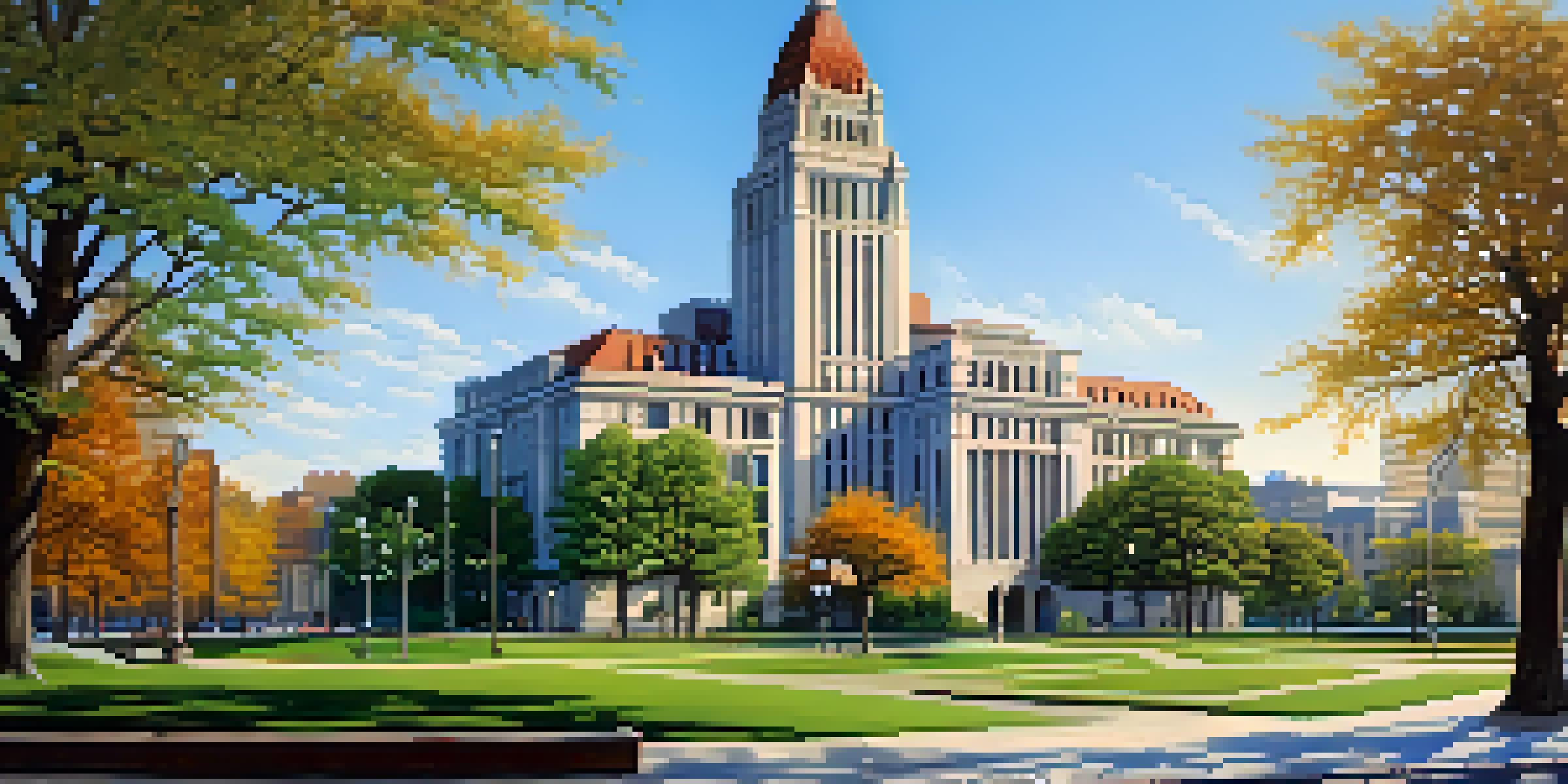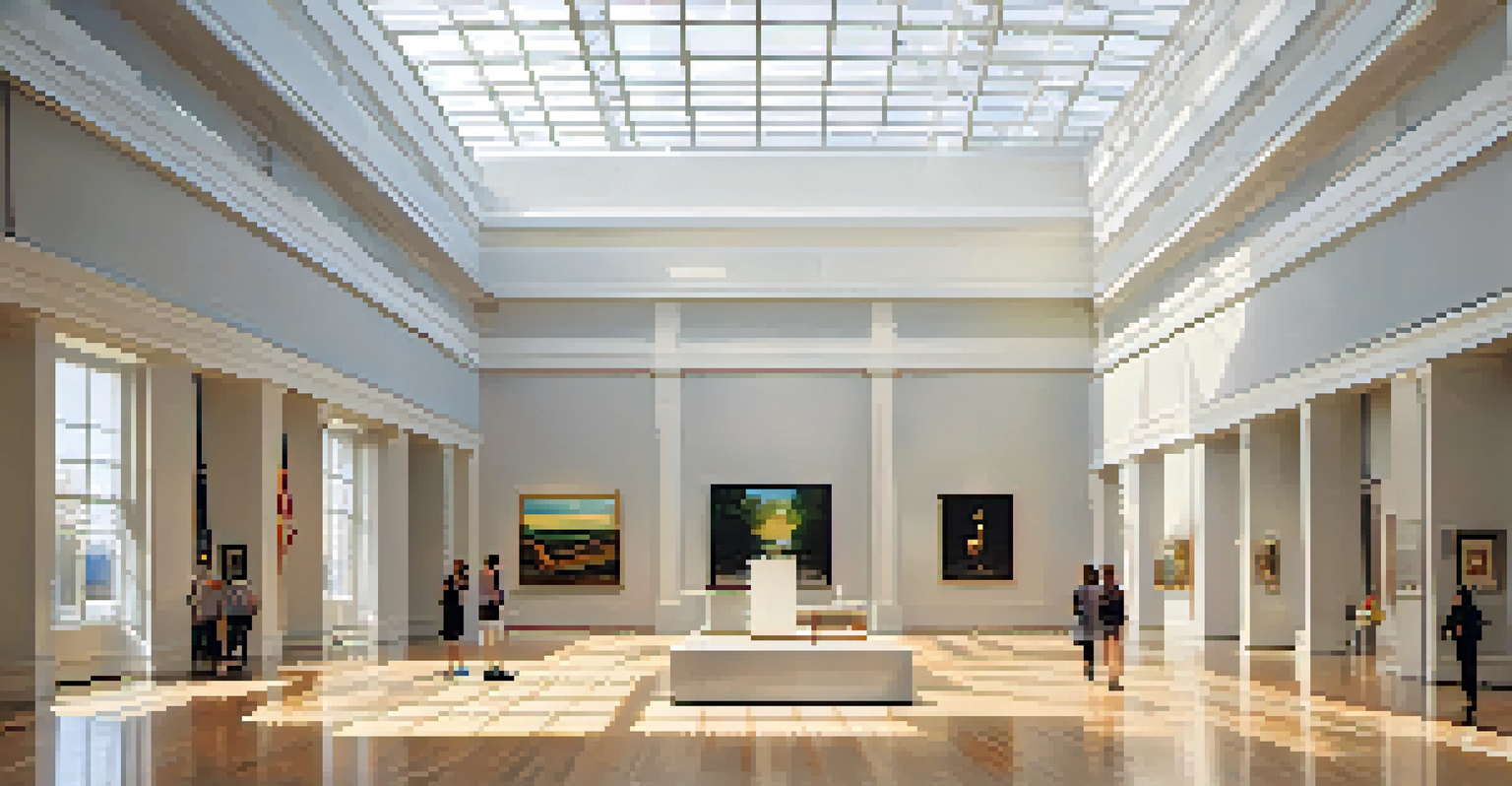Modernism in Buffalo: A New Wave of Architectural Design

Understanding Modernism: A Brief Overview
Modernism is an influential movement that emerged in the late 19th and early 20th centuries, defined by a break from traditional forms and a focus on innovation. Architects and designers sought to reflect the changing realities of the time through new materials, techniques, and ideas. This shift was not just a style but a philosophy that embraced simplicity, functionality, and a connection to the surrounding environment.
Modernism is not a style, but a philosophy that embraces change and innovation.
In Buffalo, this architectural philosophy began to take root in the mid-20th century, resonating with the city's industrial heritage and its vision for the future. As urban landscapes evolved, modernism provided a framework for constructing buildings that were not only aesthetically pleasing but also practical and sustainable. The result was a unique blend of art and utility, echoing the aspirations of the community.
Today, modernism continues to inspire architects in Buffalo, as they incorporate contemporary principles into their designs. This ongoing evolution reflects a commitment to creating spaces that are not just visually striking but also responsive to the needs of the community. Through modernism, Buffalo is carving out its identity in the architectural world.
Key Features of Modernist Architecture
Modernist architecture is characterized by several defining features, including clean lines, open spaces, and a lack of ornamentation. These elements create a sense of harmony and simplicity, allowing the materials and structure to speak for themselves. Large windows and innovative use of light are also hallmarks, bringing the outside in and fostering a connection with nature.

In Buffalo, buildings like the Albright-Knox Art Gallery showcase these key features, marrying function with aesthetic appeal. The gallery's design emphasizes openness and accessibility, inviting visitors to engage with both the art and the architecture. This approach is reflective of modernism's core belief in the democratization of space, making art and culture available to all.
Modernism Shapes Buffalo's Identity
The modernist movement in Buffalo reflects a blend of innovation and community aspirations, influencing both architectural design and urban development.
Moreover, the use of new materials such as steel and glass has allowed architects to push the boundaries of design. This experimentation not only enhances the visual impact of structures but also improves energy efficiency and sustainability. Modernism's ethos of innovation is crucial as Buffalo navigates the challenges of contemporary urban living.
Iconic Modernist Structures in Buffalo
Buffalo is home to several iconic modernist buildings that highlight the city's architectural evolution. One of the most notable examples is the Buffalo City Hall, which, while rooted in the Beaux-Arts style, incorporates modernist elements in its functionality and design. Its towering presence serves as a reminder of the city’s rich history while also embracing modern principles.
The best buildings are those that serve the community, fostering a sense of belonging and interaction.
Another significant structure is the Roswell Park Comprehensive Cancer Center, designed with a focus on patient-centered care. Its modernist design emphasizes transparency and light, creating a healing environment that fosters well-being. This building exemplifies how modernism can inform not just aesthetics but also enhance the quality of life for its users.
Additionally, the Richardson Olmsted Campus merges historic preservation with modernist ideals, showcasing the potential for innovation within existing frameworks. By reimagining these historic spaces, Buffalo demonstrates that modernism can coexist with tradition, paving the way for a future that honors the past while embracing change.
Buffalo's Modernist Movement: Key Architects
The modernist movement in Buffalo has been shaped by a number of visionary architects who have left their mark on the city. Among them, Louis Sullivan is often regarded as a pioneer, whose philosophies on form and function laid the groundwork for many modernist designs. His influence can still be felt today, as contemporary architects draw inspiration from his work.
Another significant figure is Robert Venturi, whose playful yet functional designs challenge the rigid rules of traditional architecture. Venturi's approach encourages architects to embrace complexity and contradiction, reflecting the diverse fabric of Buffalo itself. By pushing boundaries, his work exemplifies the innovative spirit that defines modernism.
Sustainability in Modernist Design
Buffalo's architects are increasingly prioritizing sustainability, integrating eco-friendly materials and energy-efficient solutions into modernist architecture.
Lastly, the contributions of local talents like Richard Upjohn and Patrick Ahearn have helped to shape Buffalo's modernist landscape. Their commitment to integrating sustainability with modern design principles speaks to the growing awareness of environmental issues in architecture. Together, these architects are not just building structures; they are crafting a narrative of progress for the city.
Modernism and Sustainability in Buffalo
As environmental concerns become increasingly pressing, modernist architecture in Buffalo is evolving to prioritize sustainability. Architects are now focusing on creating energy-efficient buildings that minimize their ecological footprint while still maintaining aesthetic appeal. This shift towards sustainability aligns with modernism's original principles of functionality and innovation.
Incorporating green roofs, solar panels, and sustainable materials are just a few ways that modernist designs in Buffalo are adapting to meet these challenges. For instance, the use of reclaimed materials not only honors the city’s history but also reduces waste, proving that modernism can be both timeless and forward-thinking. This approach resonates with the local community, as residents increasingly favor eco-friendly initiatives.
Ultimately, the integration of sustainability into modernist architecture offers a hopeful vision for the future of Buffalo. By embracing these principles, architects are not only enhancing the built environment but also fostering a culture of environmental awareness. In doing so, they are ensuring that Buffalo remains a vibrant, livable city for generations to come.
The Role of Modernism in Urban Revitalization
Modernism plays a critical role in the urban revitalization efforts taking place in Buffalo. As the city strives to rejuvenate its neighborhoods and attract new residents, modernist architecture provides a fresh aesthetic that appeals to a diverse demographic. These designs bring a sense of progress and innovation, fostering a vibrant community atmosphere.
By transforming underutilized spaces into modern, functional areas, architects are helping to reinvigorate Buffalo’s urban landscape. Projects like the redevelopment of the Central Terminal highlight the potential of modernism to breathe new life into historical sites, creating spaces that serve contemporary needs while honoring the past. This blend of old and new is vital for cultivating a dynamic urban environment.
Revitalizing Urban Spaces with Modernism
Modernist architecture plays a vital role in the urban revitalization of Buffalo by transforming underutilized spaces into vibrant, functional areas.
Moreover, modernist design encourages the development of mixed-use spaces that promote community interaction. By integrating residential, commercial, and recreational areas, these projects create a sense of place and belonging for residents. As Buffalo continues to evolve, modernism remains a key component of its revitalization narrative.
Looking Ahead: The Future of Modernism in Buffalo
As we look to the future, modernism in Buffalo is poised to adapt and thrive in response to changing societal needs. The city’s architects are embracing new technologies and materials that challenge conventional design paradigms, paving the way for innovative solutions to urban living. This commitment to evolution reflects the essence of modernism itself—a willingness to embrace change.
Community engagement will also play a crucial role in shaping the future of modernist architecture in Buffalo. By involving residents in the design process, architects can create spaces that genuinely reflect the needs and desires of the community. This collaborative approach fosters a sense of ownership and pride among residents, ensuring that modernist designs resonate on a personal level.

In summary, the future of modernism in Buffalo is bright and full of potential. As the city continues to redefine its architectural identity, modernism will serve as a guiding principle, inspiring new generations to envision and create spaces that are not only beautiful but also functional and sustainable.